|
Gavia Updated - Bolzano II Adjustable hub! |
|
The acclaimed Gavia wheelset has been updated with a brilliant but simple new axle system with an adjustable tension locknut. This amazingly simple yet revolutionary locknut allows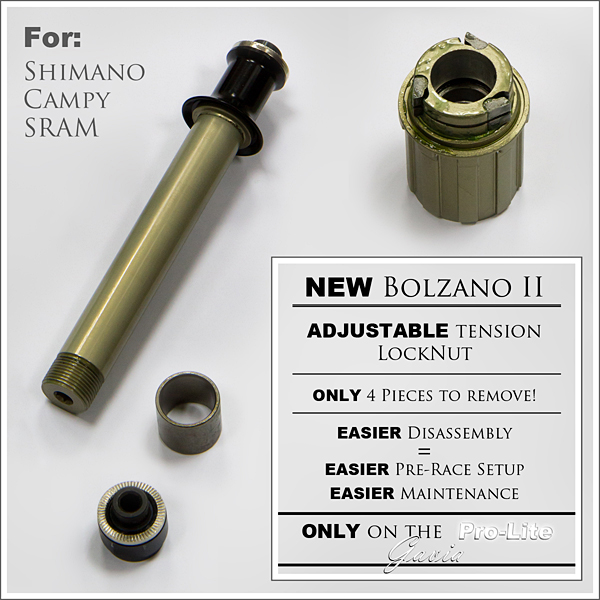 the end user to fine-tune the tension in the bearing to get the ultimate balance of smoothness, low rolling resistance without the risk of introducing play or compromising stiffness. the end user to fine-tune the tension in the bearing to get the ultimate balance of smoothness, low rolling resistance without the risk of introducing play or compromising stiffness.
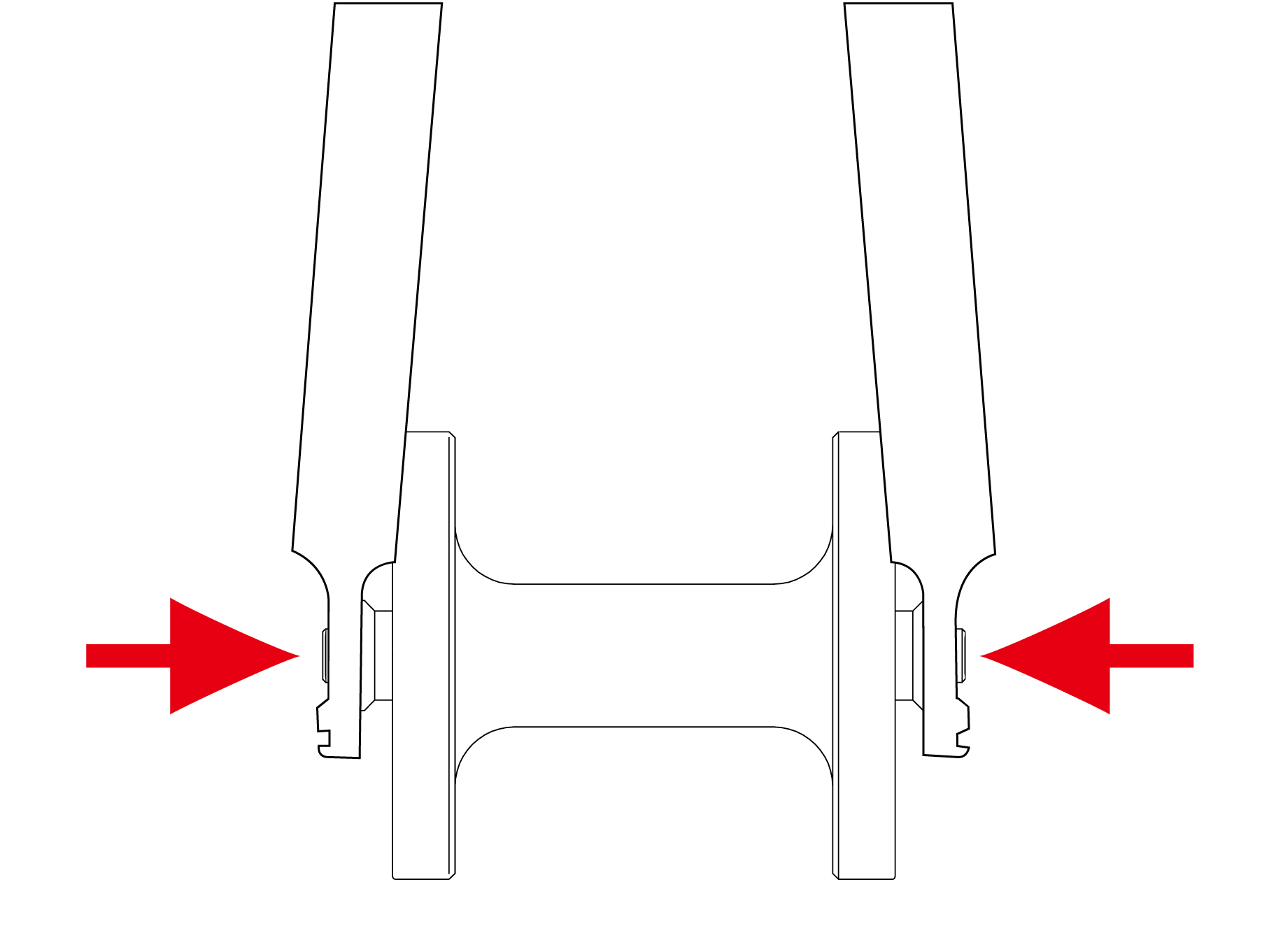 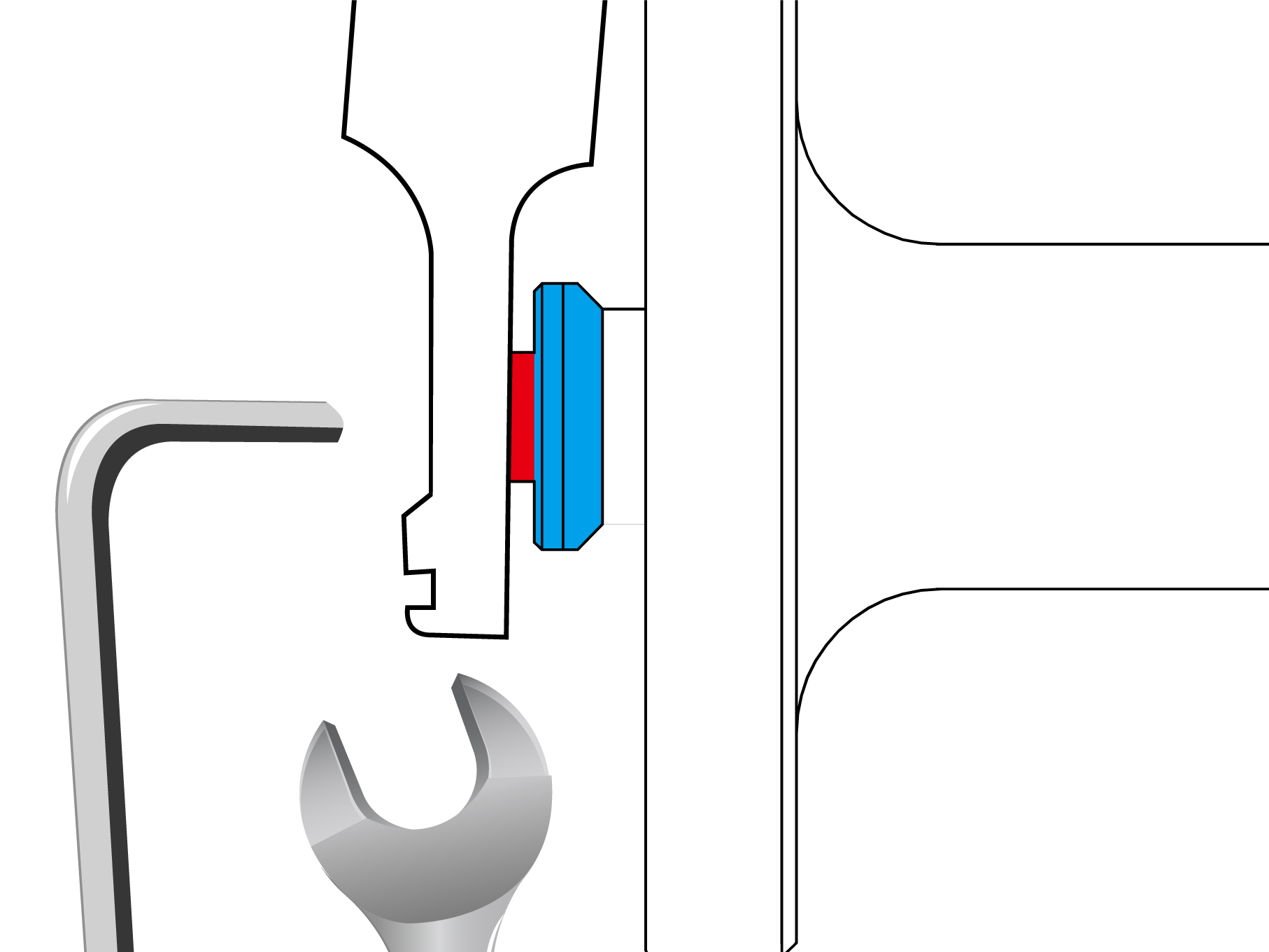 With most hubs, the tension of the thru-axle can increase rolling resistance. With most hubs, the tension of the thru-axle can increase rolling resistance.
With the new Bolzano II, there is a small internal nut that allows you to prevent the tension from overtightening the bearing internals, keeping the bearing running smooth and fast.
At the same time, the wheel is even easier to disassemble, making maintenance and race setup even easier.
And of course, offering the same trademark stiffness, power transfer and SPEED as all hand-built Pro-Lite wheels.
Look for the 2010 version with the Bolzano II hub. On the hub itself, you will find the words Gavia V2 to identify the wheel correctly.
Gavia - the Ultimate wheel for those with a taste for quality and a thirst for speed! |
|
|
|
Simon Johnson's Urban Bike Project - Photo Journal |
|
|
We had a pretty nice surprise in the wake of our Photo Contest. Simon Johnson, who took first place, 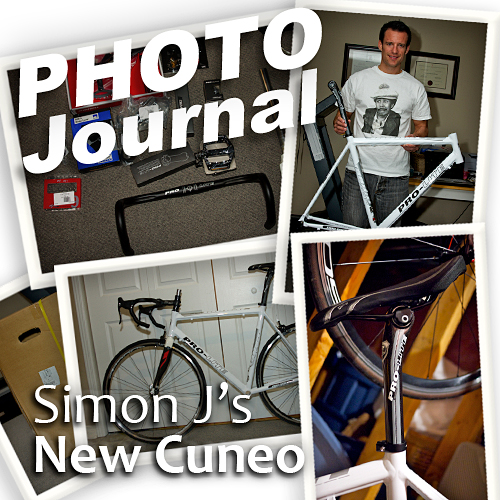 decided to do a little build project with his prize and put some of the info on his favorite forum, BikeForums.net. We thought this was pretty awesome and thought it would be a good idea to give him another place to host his Photo Journal as he builds up his custom Cuneo. decided to do a little build project with his prize and put some of the info on his favorite forum, BikeForums.net. We thought this was pretty awesome and thought it would be a good idea to give him another place to host his Photo Journal as he builds up his custom Cuneo.
Have a look and read about his setup!
The content of this article will come from Simon's public comments on the forum and we would encourage people to follow the link to bikeforums.net to see the whole story for yourself and participate in discussions.
|
|
|
|
Pro Interviews - Simon Johnson |
|
|
In the wake of our second Photo Contest, we thought it would be great to meet our first place winner, Simon Johnson. Coming from a mechanical background, he has a keen appreciation for well built gear and a smooth ride.
We especially appreciated his obvious diligence to attain technical mastery of his photographic gear to pull off the stunning shot that took the win. We wanted to learn a bit more about the story behind the man behind the pic, so here it is:
PL: What can you tell us about your background?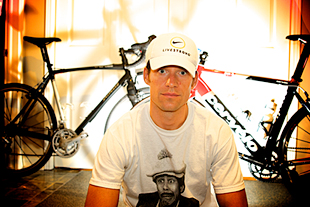
Simon: [I'm] from Ontario, Canada. I’m 34 yrs old, married, and a father of 2. I’ve always been a fitness buff, but only recently have I started cycling seriously.
PL: How did you get started with cycling?
Simon: When I was in high school, I was an avid mountain biker, riding a $400 chromalloy Concorde that I bought with grass cutting money. But university and early career choices dominated my time, and the bike collected dust, and rust, in my parents shed back home.
PL: When did you start getting back into it?
Simon: About 5 yrs ago, I started running and began entering 5K and 10K races with pretty good results. I also picked up another mountain bike and started riding casually, mostly commuting and riding with my kids in a bike stroller.
My passion for road riding is still in its infancy. This past spring, I bought a cyclocross bike, hoping to take some of my casual trail riding onto the road as well. Since then, its been all road, and lots of it. After over 2500kms ridden on my Tricross this summer, I bought my pride and joy – a 2010 Cervelo S1.
PL: Wow, that's a nice ride for a guy someone just getting into it. What can you tell us about the bikes in your stable?
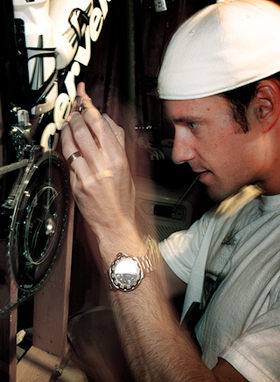
Simon: My current kit:
- Specialized Tricross cyclocross bike with Shimano R500 wheelset and Pro-Lite Caressa aero seatpost.
- Cervelo S1 Ultegra with Soul 3.0SL wheelset
PL: Where do you see yourself heading with your riding?
Simon: I haven’t started racing yet, as I am still building my confidence, speed and technique. However, I’m keeping my eyes peeled on local cycling club websites for entry level CX and road races – both of which I’m very excited about.
PL: What kind of riding do you do for fun?
Simon: I enjoy both group and solo rides. There’s nothing better than going out on a crisp Canadian morning and riding the quiet back roads in Eastern Ontario. Aside from riding, I love tinkering and tuning both bikes. As a car guy, I was always in the garage with my tool chest and a popped hood. Now, I’m in the basement always listening for clicks and rattles, making sure everything is perfect.
PL: What is exciting about Pro-Lite for you?
Simon: Pro-Lite is a very unique company, in that they offer very attractive, functional products at a great price. As common and insignificant as a seat post is, several of my cycling friends have commented on it. To win their photo contest and have a chance to build a Pro-Lite frame from scratch is huge for me. 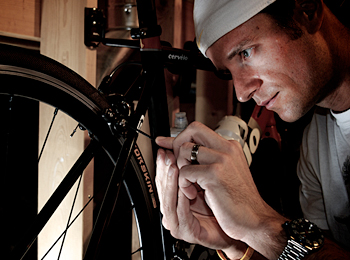 Not only will I have another bike to ride, but the process of building it from the bottom up will be invaluable to me. Photography has always been a casual hobby of mine. This is the first time any of my photos have paid off!! Not only will I have another bike to ride, but the process of building it from the bottom up will be invaluable to me. Photography has always been a casual hobby of mine. This is the first time any of my photos have paid off!!
PL: Those are some pretty impressive pics. I know that you mentioned that you are not a professional photographer, but you seem to have a very good handle on the use of external flashes. Can you give an insider's look on your photography for those who might not be so skilled?
Simon: No problem. My photography hobby stemmed from my love for Formula 1. I was at the Montreal Grand Prix one year with a point and shoot, and I couldn't get any good pictures because the cars were moving so fast. It was then that I decided I wanted a DSLR, and it spiraled out of control, in a good way, from there.
I'm not a typical Nikon or Canon guy. I actually shoot Sony. My current kit includes:
- Sony A700 DSLR (I also have an A350 as a backup)
- Numerous lenses, including the Sony 70-200 f2.8, and Carl Zeiss 24-70 f2.8
- HVL42am wireless flash
My passion is shooting motorsports. But I also love photographing my kids, as well as setting up intricate studio shots (the studio being my basement) using my strobes. Some of my work can be found here.
I will for sure keep a photo journal during my Pro-Lite bike build.
PL: We look forward to seeing that!

|
|
|
|
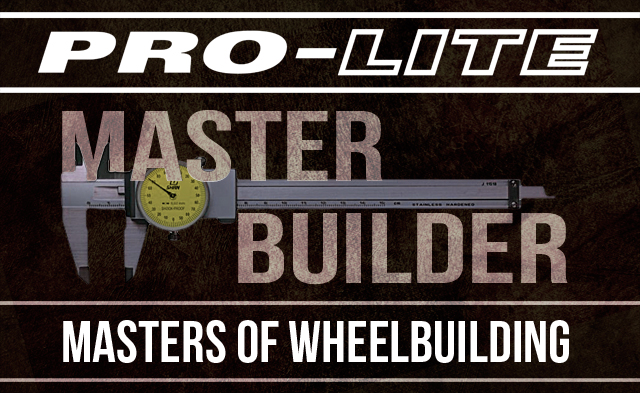 Building thousands of wheels every year, our factory staff can certainly be said to be among the most experienced in the business. Every stage of wheel building is carried out completely by hand, using the best quality tools customized to be the best for every job. Building thousands of wheels every year, our factory staff can certainly be said to be among the most experienced in the business. Every stage of wheel building is carried out completely by hand, using the best quality tools customized to be the best for every job.
If you watch a wheel being built at your local bike shop, you will probably see some of the basic steps:
lace up, quick tighten, first tension, check dish, tweak the tension, then put the wheel on a stand to even up the tension and fine tune the trueness and roundness. Some of the better shops will even use a tensiometer and might even do a bit of bedding in by pushing the hub against the ground...
Compare that to the stringent standards used by Pro-Lite. The initial stages are fairly similar, but the difference is found in taking the time to prepare the wheel as much as possible, checking and re-checking and checking again. We even check and re-check the tools, carefully monitoring the longevity of the springs and keeping calibrated, never being more than a few hours away from calibration.
We took a camera in and watched a wheel as it went through the process here at the biggest exclusively hand-built wheel factory in the world. |
 |
From the very first stages, the wheel is built by experienced hands. The builder here is Mrs. Cai, who has been building wheels for well over 20 years. Her watchful eye and skillful fingers look for defects in spokes, nipples, threads, hub and rim before the wheel moves to the next station.
|
The next step sees the wheels go through the quick-tighten, with an air drill set to a low speed and clutched to very low resistance, well below tension thresholds. The builder is able to hold the spoke loosely without danger of overtightening. |
|
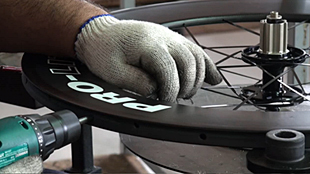 |
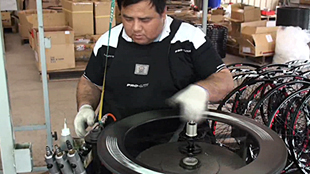 |
With the wheel loosely tightened, it is now ready to go for tensioning. Working this station today is Mr. Zhen, who is one of the newer employees, with only 8 years of wheel building experience, but still with the experience of thousands of wheels built.
|
The wheel then moves to the first tensioning stage. Every aspect of the wheel is examined as it is worked up to a near-usable tension level. Dish, roundness and trueness are all brought to a basic platform that for some factories would be good enough to package and send out the door. |
|
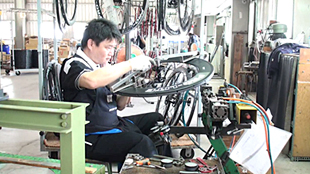 |
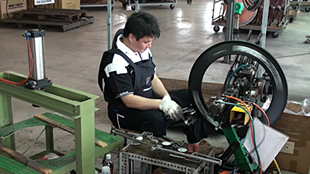 |
| The wheel building stand we use is fitted with all sorts of testing equipment that allows the builder to watch every dimension of the wheel. |
Extreme precision is a priority at our factory. As the largest customer of DT Swiss tensiometers, we make sure that all of our builders are skilled at maintaining, using and rebuilding the tools of their trade. These gauges are each numbered and the amount of correction needed at each recalibration is monitored. When the tool is tired, it is rebuilt or tossed. |
|
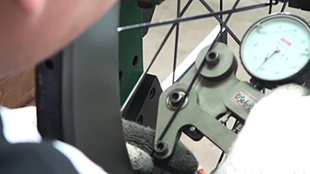 |
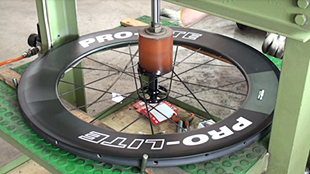 |
This machine sits conveniently next to the wheel building machine so the wheel can be bedded in with strong, consistent lateral forces appropriate for the type and number of spokes.
|
Then, it's back on the stand for another check.
This process is repeated several times and is responsible for the wheels being able to stay as true as they were when they came out of the box. |
|
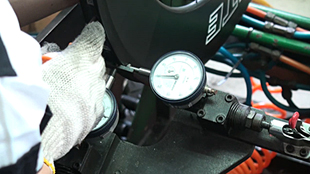 |
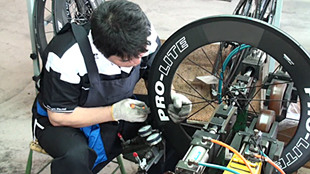 |
Once the wheel is tweaked to perfection, it's not finished yet! The wheel will move onto a rack to relax and move on to the QC department, headed up by a graduate of an engineering technical institute who has been working in the bicycle industry for 20 years since he cut his teeth as a mechanic working on F-16 fighter jets.
|
In this final stage, the wheels are put through their paces in a variety of tests designed to reflect real world usage by real riders. |
|
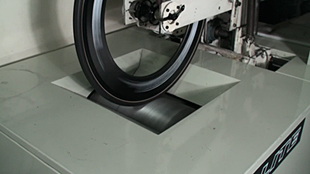 |
|
|
|
Masters of Frame Building |
|
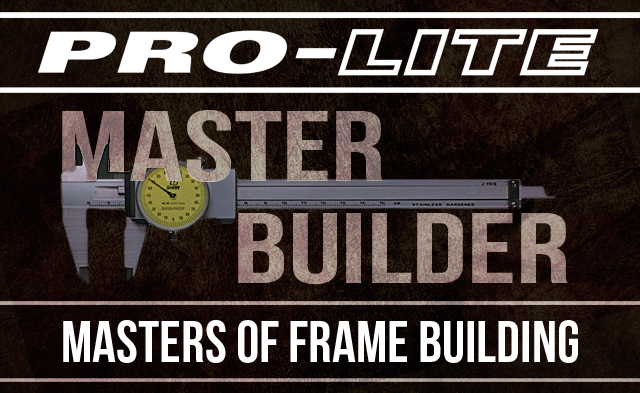 What makes a bicycle frame good? What makes it great? What makes a bicycle frame good? What makes it great?
As the heart of any bicycle build, the frame carries the identity of the bicycle as much to observers as it does to the rider. The geometry, the rigidity and other characteristics of the materials, the build quality and even the appearance all come together to give the personality - the soul of the bicycle. A tiny change in any of these key aspects can make a tremendous difference to the relationship that the rider has with the bicycle.
It is obvious when looking at a frame that it's a much simpler object than a wheel. Yet anyone who has ridden many bikes will tell you that two bikes that look "pretty much the same" can be different in a way that makes one a cherished and faithful partner, where the other could just be the "weak link in the chain" that gets banished to the garage on training days and cursed on race day.
So what makes this difference? Truthfully, it can be said that for some people, it is just a matter of personal preference or taste. However, in most cases, if you have consulted with experienced bike sizing experts and you know your style as well as intended type of riding, you can eliminate much of that indecision.
There is no substitute for a properly fitted bike!
It might even be said that barring blatant manufacturing flaws, the biggest factor that makes people label a bike as "no good" may be poor fit. After all, so many professional riders seem to be able to put in incredible race times regardless of whether they are riding this brand or that brand.
| What are the Keys to a great bike? |
- Geometry
- Power Transfer
- Reliable Strength
|
But once the fit is locked down, what can take a bike from good to great?
We believe that the first key is suitable Geometry. The next key is Power Transfer and the final key is reliable Strength.
What makes Pro-Lite Frames so special?
In preparing this article, this question was posed to the very people running the show.
| Staff Profile: Who is he? |
Position: General Manager
Name: Jasper Chen
Experience: 10 in the BMX and MTB industry, 20+ years in Racing/Triathlon/Track biyclces
Education: Trained in the Military in Taiwan and studied further in engineering and design in the US |
The first stop was the General Manager, the guy who takes care of everything from sourcing raw materials, to resolving manufacturing issues at the factory, to working with prototypes to find the issues before they come up. His first response was about the tubing we use. It's natural for him to think of this because he was the guy that originally found the source of the unique 7046 alloy that Pro-Lite uses to make light, strong and amazingly affordable frames that rival Scandium. It is his years of experience that has helped as he has worked closely with our factories and welding staff to understand the unique needs of each type of bicycle at the most fundamental levels, resulting in our frames being built as all frames should - Perfectly! Having said that, his suggestion was to take a closer look at the geometry.
The Geometry for our bikes was supplied by the CEO. What does he know of geometry? He has been racing since he was 13 - taking his Pro card at the age of 22 - and has raced literally every type of bicycle race you can imagine in virtually every part of the globe you
| Staff Profile: Who is he? |
Position: CEO
Name: Steve Fenton
Experience: 34 years building frames, Pro Racer since age 22.
Education: Mechanical Engineering, Sales and Marketing, Commercial Business studied at government training bodies in the UK |
could think of right through to 1991. Since it really is a rarity that bicycle manufacturing decisions are made by people with actual racing experience, it is no small advantage to have someone at the helm who can see not only "both sides of the issue", but is actually familiar with the many differences in each type of racing and how they are served by specific aspects of the bicycle and its geometry. Starting as part of his engineering apprenticeship training at Fairey Engineering at the age of 16, he had the freedom to experiment with many variations in design as his racing plans called for them. In spite of being told that "alloy could never be used for a bicycle", he chose to focus on building alloy frames. Now, working with Jasper and Pro-Lite's skilled staff, they are able to lock down frame designs that target each facet of cycling, not by following the way everyone else does it, but designing with geometry learned from experience - the best way that works!
It is also on the experience of Steve that Pro-Lite places such a high importance on Strength and Power Transfer. With literally hundreds of races under his belt, he knows exactly what it feels like to experience a breakage of every part of a bicycle - and most bones in the human body. He also understands that even if you don't end up on a stretcher, you can't win a race if your bike is in pieces.
Likewise, if your bike is flexing around like a strand of well-cooked spaghetti, you might as well be pushing your competitors ahead of yourself. Energy wasted is energy lost. When seconds count, the last thing you want is to be pushing down on the pedal and putting that energy into your bike's flex to be soaked up like a sponge before the next pedal stroke. It's no coincidence then that many people who ride Pro-Lite immediately notice the snappy responsiveness of wheels and frames designed to Transfer your Power into Speed.
| Staff Profile: Who is he? |
Position: Quality Control Director
Name: Wei SiQi (aka Whiskey)
Experience: 11 years as Fighter Jet (F-16) mechanic for the military, 20+ years in bicycle manufacturing
Education: Military mechanics and materials engineering training - Taiwan Military Aviation Technology Institute |
Our QC Director pointed out that frames can be made by anyone with a welder. Indeed, anyone with a little experience can build a jig and make a frame. From his point of view, the most important thing to watch is preparation. A little known fact about welding is that it can easily take as much as 10 times more time to set up and check that everything is correct than it does to complete the welding. With the tubing prepared for welding by computer controlled CNC machines, it's not difficult to put a headtube on straight. The real focus for the QC department is the alignment of the whole frame - from the head tube to the rear dropouts. Drilled into the welders and QC staff alike is the critical need for perfect alignment. This is vital for control in any high speed environment.
The input from these key individuals has what impact on our production then?
- Clean, organized working environments.
- Quality assured by using computer directed cuts with all tubes CNC cut in preparation for welding.
- Perfectly aligned frames, from the head tube to the rear dropouts
- Strong frames, made with quality tubing drawn to application-appropriate thicknesses and shapes.
- In-house control over welding and bonding
- Geometry tried and tested for every avenue of racing
|
Every frame that comes out of our factory is ready to race - ready to win - right out of the box. |
|
|
| << Start < Previous 1 2 3 4 5 6 7 8 9 10 Next > End >>
| | Results 28 - 36 of 208 |
|